From Zero to Hero: How to Get Traffic to Your Shopify Store Quickly
I'm looking for...
Are you struggling to figure out how to get traffic to your Shopify store? Wondering where most Shopify stores find their visitors?
In this article, I’ll explore the major sources of Shopify traffic, from paid ads to organic search, social media, and more.
Ready to unlock the secrets to boosting your store’s visibility and sales? Dive in and discover practical tips and tricks for driving more traffic to your Shopify store!
Create Your Online Store in just 5 Minutes – For Free
Pick your niche, our AI builds your store, add 10 winning products and we teach you how start selling today. Start picking your niche
Where Do Most Of The Shopify Stores Traffic Come From?
 Traffic from Mobile Devices
Traffic from Mobile Devices
A substantial share of traffic to Shopify stores originates from mobile devices, making up about 69-70% of all transactions.
This highlights the necessity of optimizing Shopify stores for mobile users to effectively capture the increasing number of mobile shoppers.
 Traffic from Search Engines
Traffic from Search Engines
Search engines, especially Google, are crucial in driving traffic to Shopify stores.
Organic search is significant, with Google alone providing up to 80% of all trackable website traffic. This underscores the importance of search engine optimization (SEO) in attracting visitors to Shopify stores.
 Traffic from Social Media
Traffic from Social Media
Social media platforms are also key traffic sources for Shopify stores. Instagram is particularly effective, especially for UK-based Shopify merchants.
The integration of e-commerce features on these platforms facilitates direct shopping experiences and boosts store visibility.
 Email Marketing
Email Marketing
Email marketing remains a powerful tool for driving traffic to Shopify stores.
So, personalized email campaigns achieve high conversion rates, with email-generated traffic showing an average conversion rate of 4.29%.
The direct reach of email marketing enables merchants to send targeted offers and updates to subscribers, enhancing engagement and sales.

 Referral Traffic
Referral Traffic
Referral traffic is another important source of visitors for Shopify stores. This traffic comes from other websites that link to the Shopify store, such as blogs, review sites, and partner websites.
Effective referral strategies include collaborations with influencers, affiliate marketing, and partnerships with other businesses to drive traffic from their audiences to the Shopify store.
 Paid Ads
Paid Ads
In addition to the main channels mentioned above, other sources such as paid advertising also contribute to the overall traffic of Shopify stores.
Check out the Best Shopify Marketing Tactics and Strategies You Can Use To Sell More.
How To Get Traffic To Your Shopify Store? My Top 18 Approaches
In this blog article, I will share with you the top 18 strategies that helped me get traffic to my Shopify store.
Also, I will provide you with some tips and tricks on how you can start with each of the strategies.
1. Search Engine Optimization
SEO (Search Engine Optimization) is crucial for making your Shopify store easy to find on search engines like Google. Think of SEO as your magic tool to increase your store’s visibility.
A well-optimized SEO strategy helps your Shopify store appear higher in search results, attracting more visitors who are already interested in what you offer.
To see significant results, aim to get your site on the first page of Google search results. Even better, being in the top 5 spots can dramatically increase your visibility.
Statistics reveal that a staggering 75% of customers don’t look past the first page of search results. Most users click on one of the top 3 links, as these usually provide the answers they need.
This highlights the critical importance of having a well-optimized SEO for your Shopify store.
For instance, if you search for the keyword “build online store,” you’ll notice that the top link often belongs to Shopify. This shows that when people search for building an online store, they frequently turn to Shopify’s content.
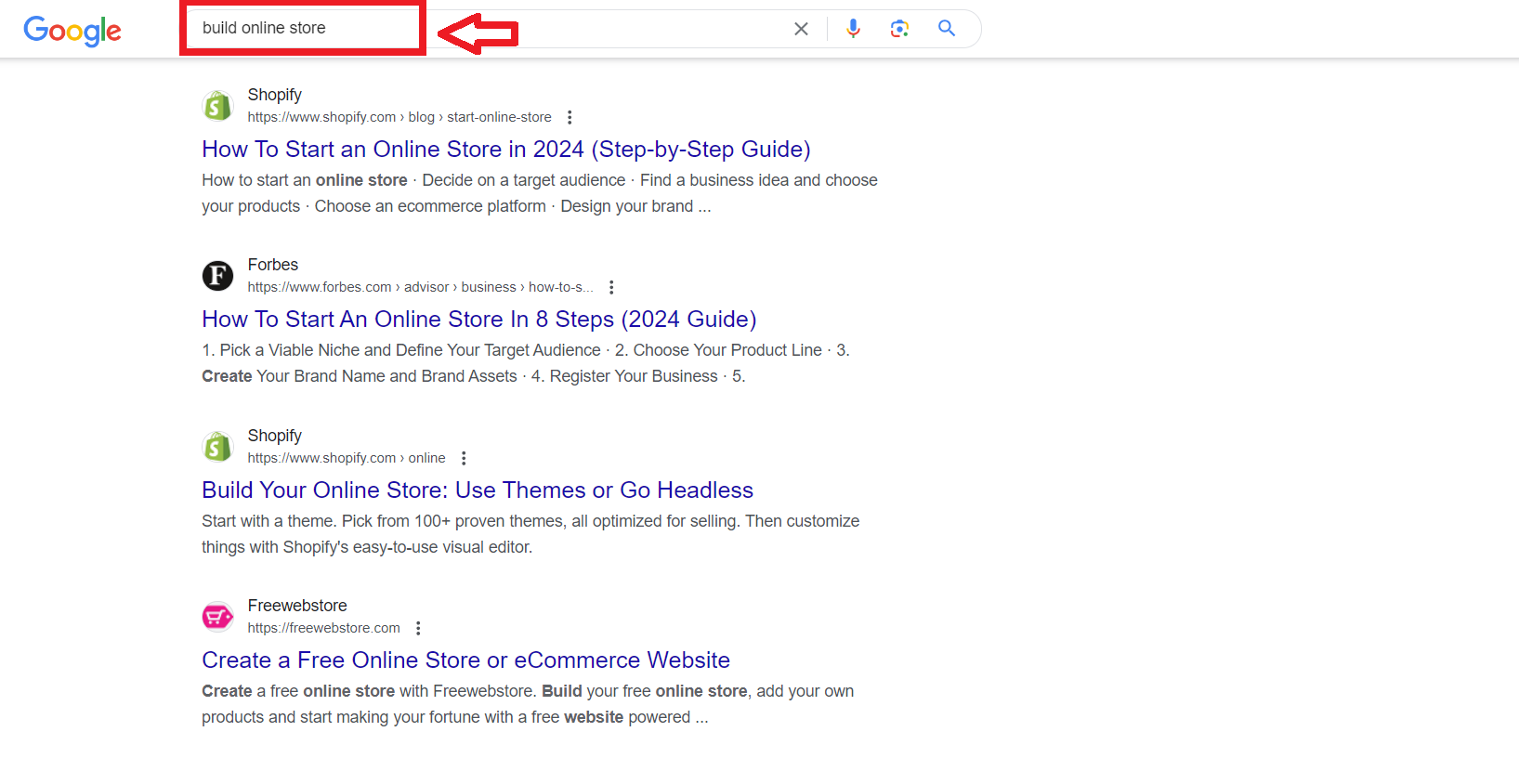
By optimizing your SEO, you can ensure that your store ranks high, driving more traffic and potential sales to your site.
2. Use Relevant Keywords
Keywords are essential for improving your SEO ranking for your Shopify store. They help search engines understand your content and connect it with potential customers.
So, using tools like Ubersuggest can help you find relevant and related keywords for your Shopify store.
Let’s try this out. By searching for keywords related to Shopify stores, you can gain insights such as search volume, keyword difficulty, traffic, keyword ideas, and content ideas.
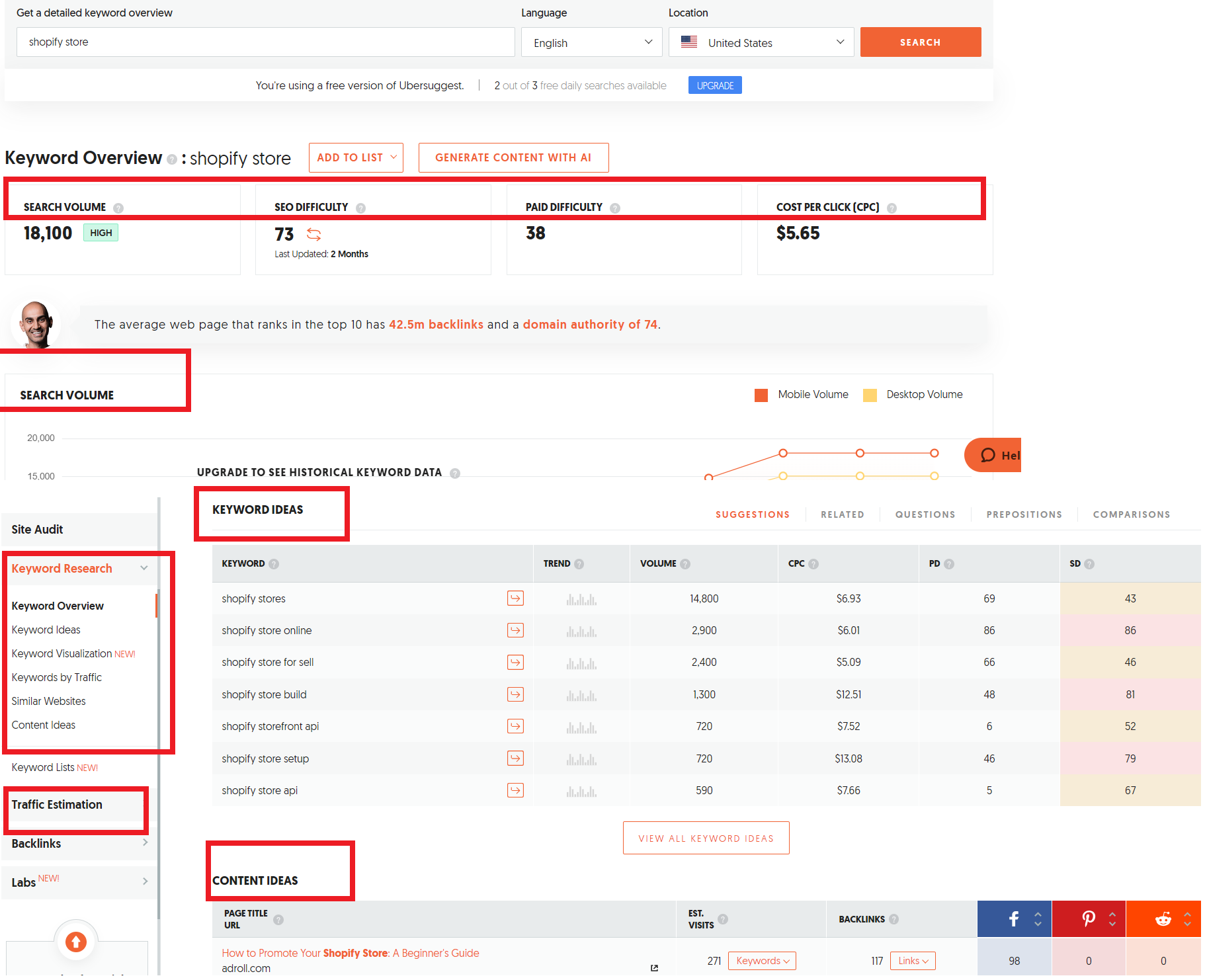
This information helps you make informed decisions about which keywords to use.
Starting out can be tough because your website’s online presence is still growing. To overcome this, focus on low-competitive keywords.
So, tools like SEMrush can help you find these keywords. SEMrush offers a premium plan with a vast database of keywords, showing you how competitive they are and in which countries they rank.
For example, the keyword “dropshipping” is highly competitive in the USA with a difficulty of 78%. However, SEMrush provides alternative keywords and related questions that are less competitive.
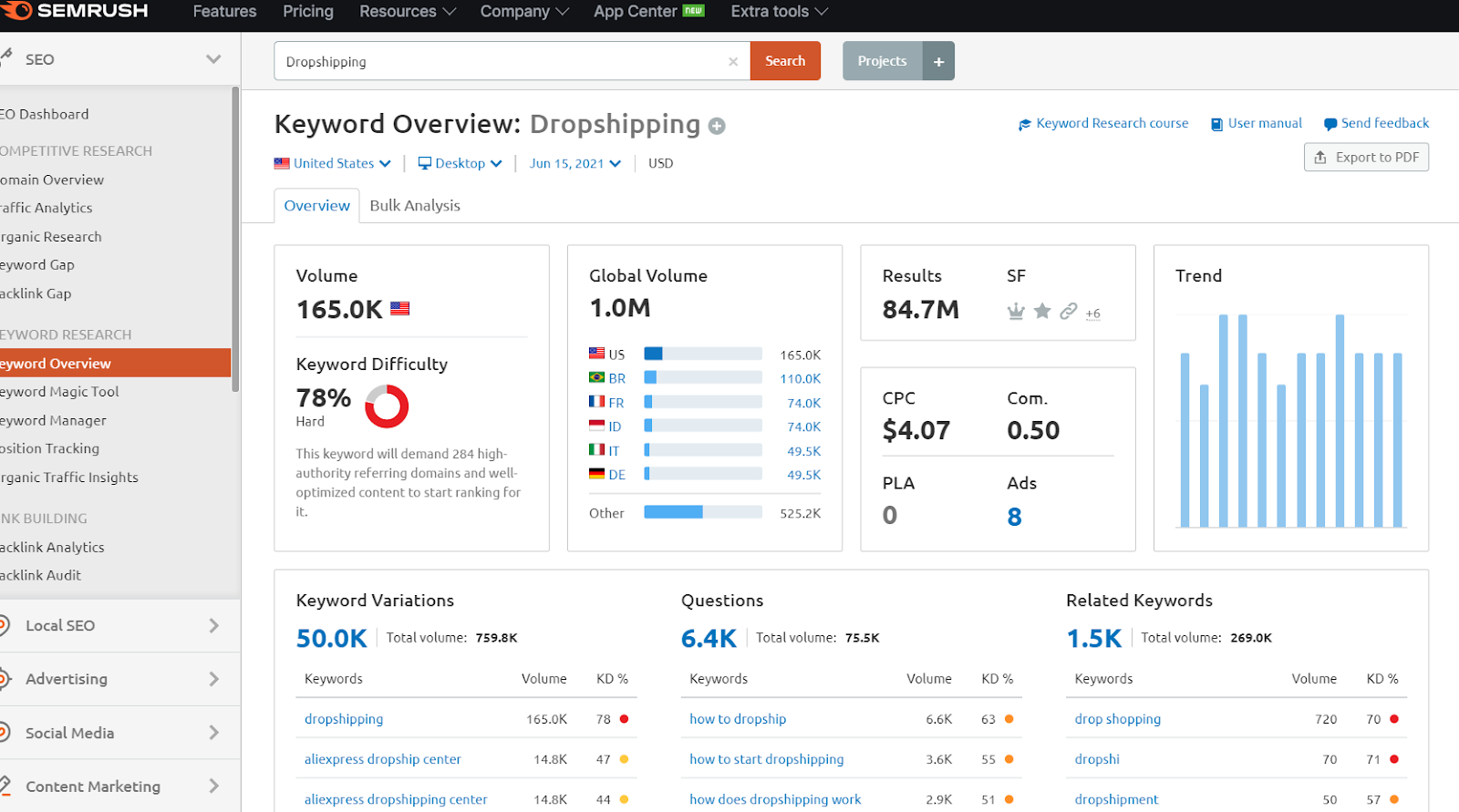
So, if you are new to this world, low-competition keywords might be a good strategy, since they are easier to rank for.
Moreover, this is especially useful when entering low-competitive niches. Last month, I used SEMrush to explore keywords for dropshipping electronics, like drones, and found a keyword difficulty of 33%, indicating lower competition.
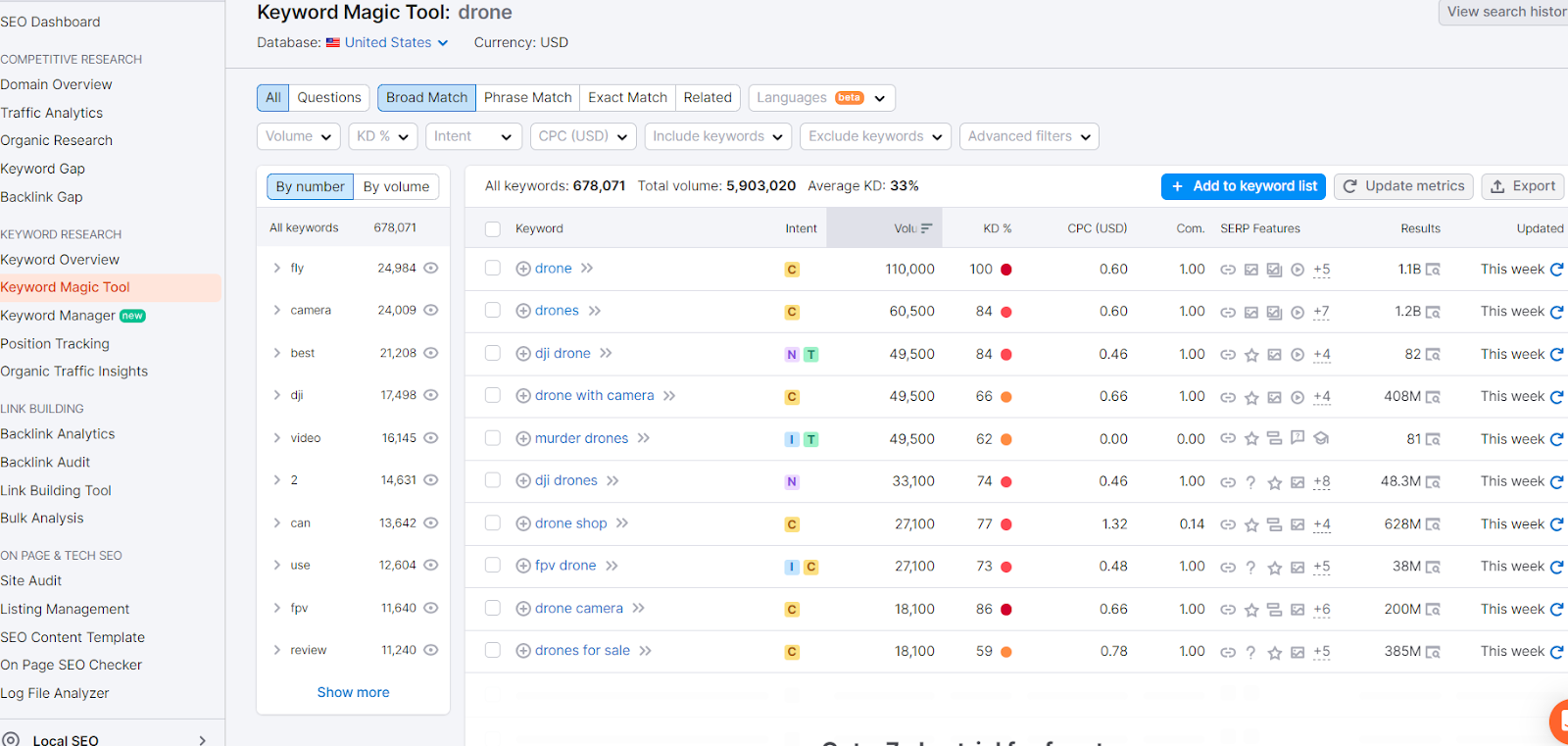
Another helpful tool is the Google Keyword Planner. It offers alternatives and shows the competitiveness of keywords in your target country.
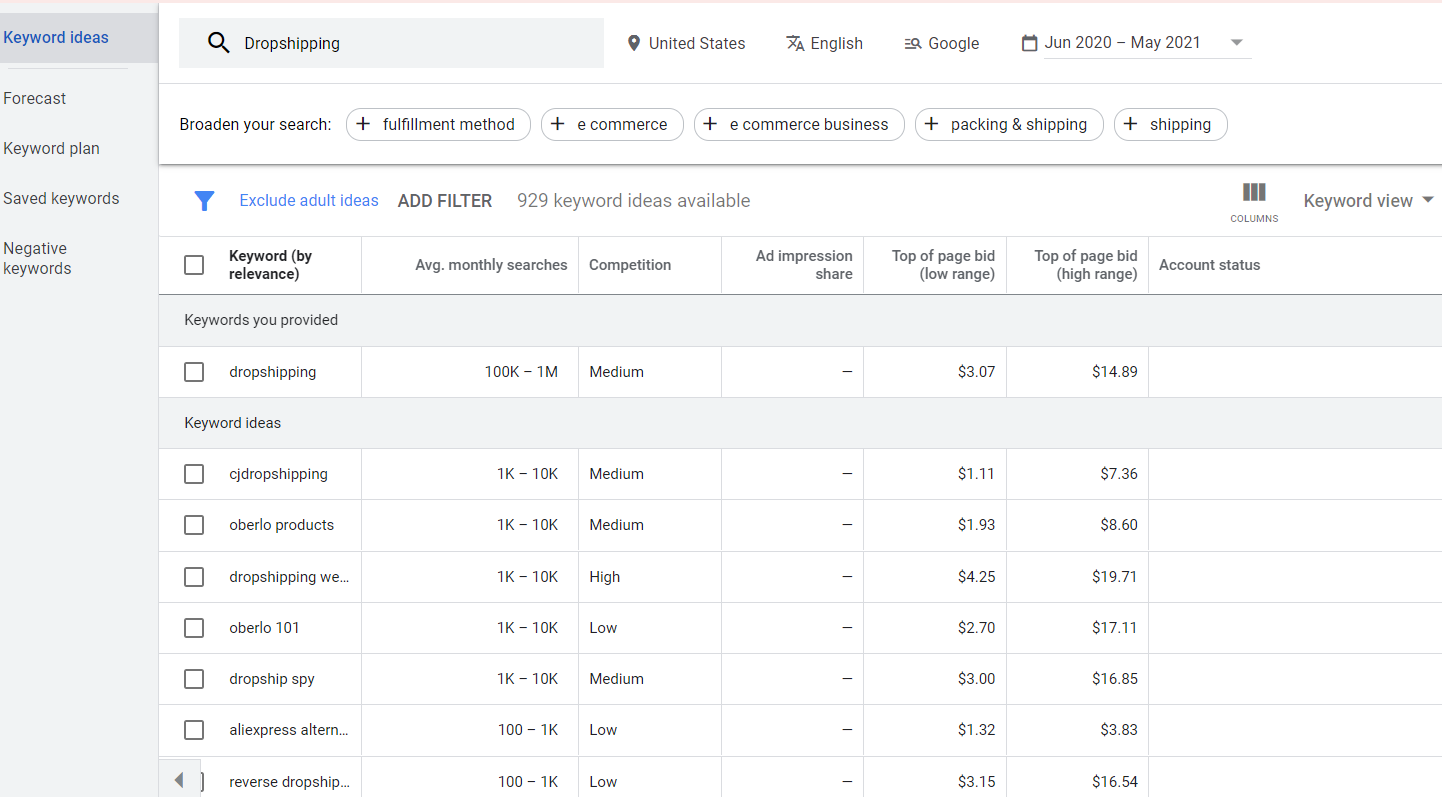
Whether you use Google Keyword Planner or SEMrush, both will provide valuable keyword suggestions based on your targeted area.
For instance, keyword competitiveness in Europe will differ from that in the USA.
3. Crafting Effective Meta Descriptions

Meta descriptions play a crucial role in attracting visitors to your dropshipping website. These are the short blurbs you see below the headline in search results.
Though often overlooked, a well-written meta description can significantly increase your click-through rate.
So, here’s my advice: Keep your meta descriptions short and sweet—ideally around 155 characters. Make sure to include your main keyword to improve SEO and relevance.
People prefer brief descriptions as they are easier to digest and understand.
When crafting a meta description for a dropshipping site, include something unique that entices users to click. This could be a special offer, a unique product, or a limited-time discount.
For example, I use ChatGPT prompts to help me create SEO-friendly meta descriptions.
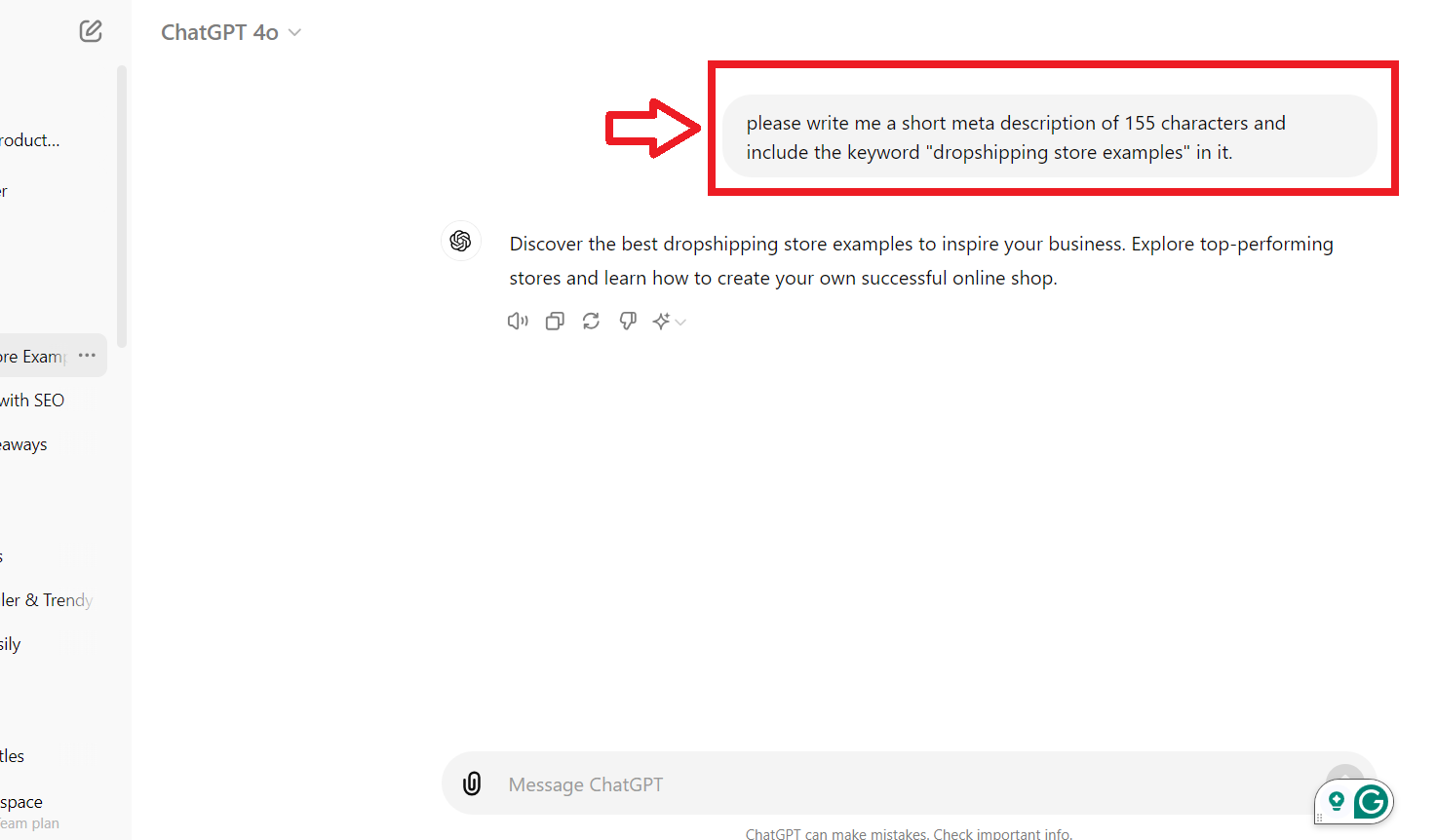
Here’s another quick example:
“Get the best deals on unique dropshipping items. Fast shipping & exclusive discounts!”
This concise description includes a clear call to action and highlights what makes your store special, encouraging users to click.
By focusing on well-crafted meta descriptions, you can effectively draw more traffic to your Shopify store.
4. Enhance Traffic to Your Shopify Store with Internal and External Links
Firstly, internal links are crucial for Shopify websites. They connect different pieces of content on your site, guiding visitors from one article to another.
This not only improves navigation but also boosts your SEO. However, new Shopify stores might find this challenging due to a lack of content. That’s why it’s essential to create as much content as possible when starting out.
Once you have substantial content, internal links keep traffic circulating within your website.
The best part? No permission is needed since you own the content. For instance, linking a product page to a related blog post can enhance user experience and keep visitors engaged.
On the other hand, external links are hyperlinks that point to content on other websites. These links are valuable for building credibility and authority. However, some websites restrict the use of their links to prevent misuse.
So, reliable sources like Statista, Wikipedia, or trusted partners can be excellent choices for external links. They help improve your site’s visibility and trustworthiness.
For instance, using SEO plugins like YOAST can help you manage these links effectively, ensuring you’re using permissible and beneficial external links. These tools provide insights on link usage and optimization.
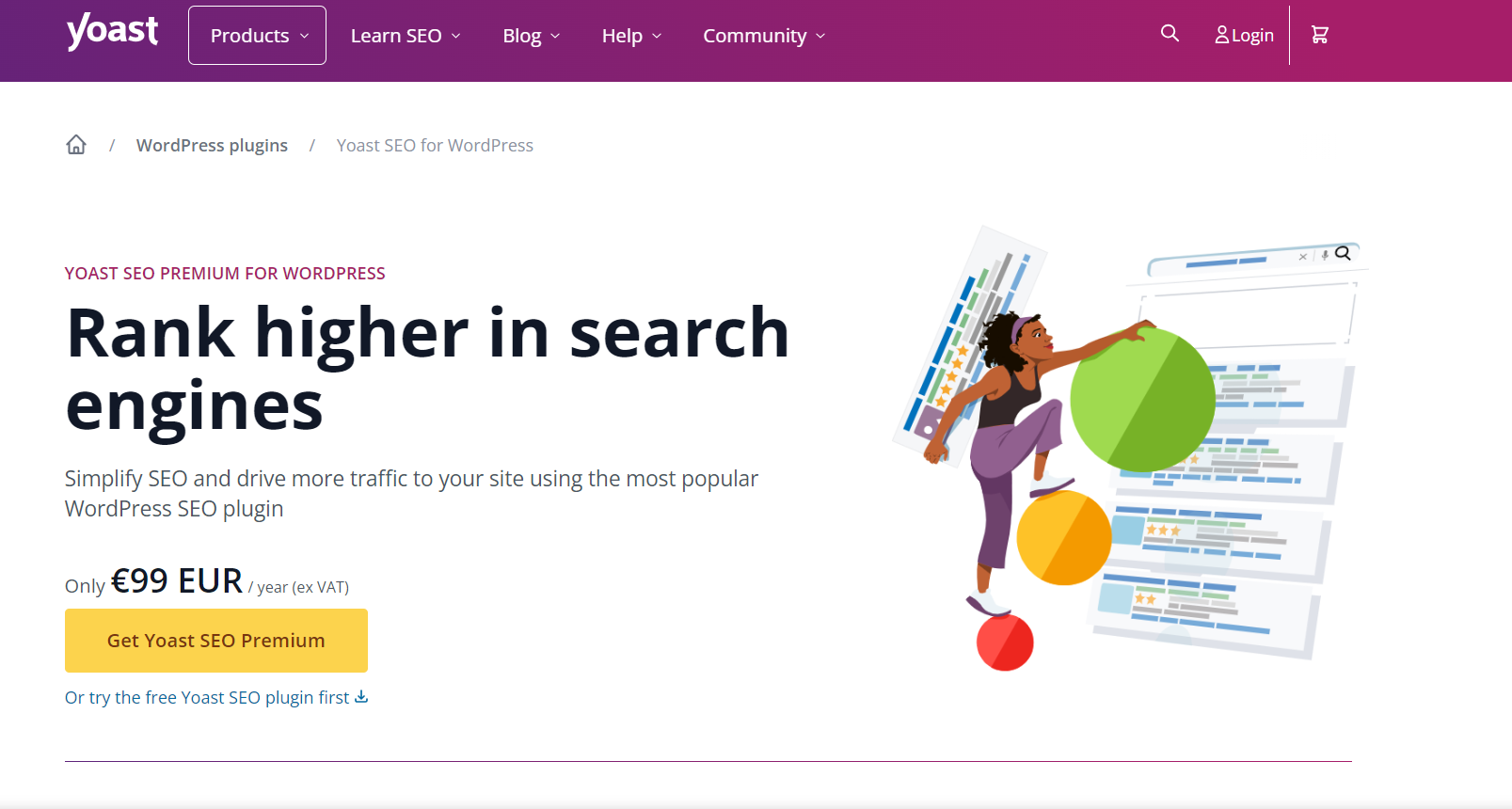
Also, various SEO apps can assist you in analyzing your linking structure. For example, I use Ahrefs to check for the most linked pages, broken links, and traffic-generating pages.
This helps in make informed decisions to optimize my Shopify store’s performance.
5. Write Creative Headlines
When it comes to driving traffic to your Shopify store, headlines are crucial. A poorly crafted headline means fewer clicks on your Shopify store link, which means lower traffic on your site.
Headlines are so important that many content creators spend up to an hour perfecting them. A headline is the main reason someone will click on your article or website. If it’s not compelling, your content won’t get read.
To attract readers, your headline needs to be catchy and informative. It should give a clear idea of what the article is about before anyone clicks on it. More clicks on your Shopify website mean better SEO rankings.
Moreover, make sure to include the main keyword relevant to the content. Whether you’re discussing products, sales, SEO, or ideas, make sure your headline is closely related to your article’s topic.
Here’s my advice for writing a headline:
- Reflect the content accurately. Misleading titles can lead to high bounce rates and hurt your SEO.
- Include relevant keywords near the beginning. Search engines prioritize the first few words.
- Keep it short and sweet—50-60 characters to avoid truncation in search results.
- Be clear and simple.
- Know your audience and use language that resonates with them.
- Minimize unnecessary words, but ensure readability.
- Use numbers if relevant (e.g., “Top 15 Tips,” “8 Strategies”). Numbers grab attention and suggest a structured format.
For instance, I use ChatGPT to generate headline ideas. Let’s try it out for an article on the dropshipping jewelry business.


6. UI/UX Design/Website Structure
The overall UI/UX design and structure of a website significantly impact your Shopify store traffic.
Websites with simple and intuitive designs tend to look more professional and offer a better user experience.
A poor UI/UX can turn away many visitors, making your Shopify website appear untrustworthy. On the other hand, a well-designed website keeps visitors engaged and increases the likelihood of conversions.
Thankfully, Shopify website builder offers an excellent design and navigation. Shopify offers hundreds of pre-made templates that you can customize to fit your brand and style.
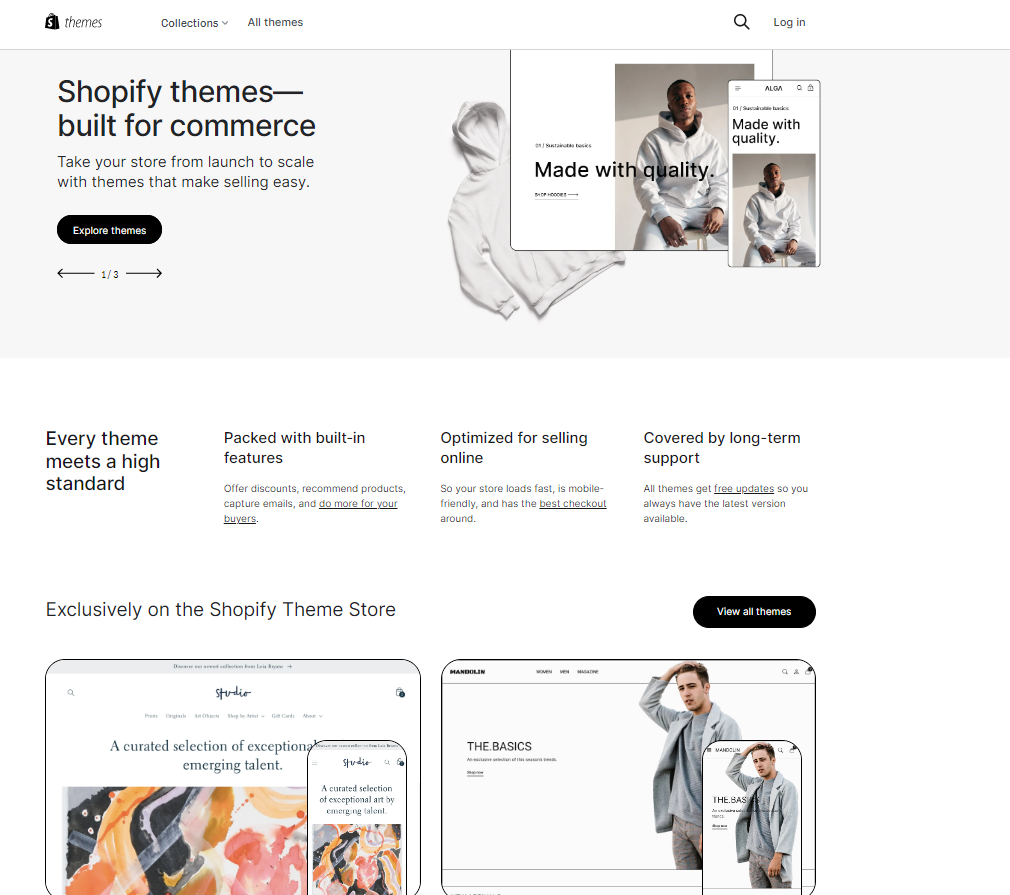
Good UI/UX design makes your website look polished and professional. It includes elements like easy navigation, fast loading times, and mobile responsiveness.
These factors not only improve user experience but also positively impact your SEO and drive traffic.
Here are some tips for improving your dropshipping store’s UI/UX:
- Choose a clean, simple design: Avoid cluttered layouts. A minimalist approach often works best.
- Ensure easy navigation: Visitors should be able to find what they’re looking for quickly. Use clear menus and a logical structure.
- Optimize for mobile: Many users browse on their phones, so make sure your site is mobile-friendly.
- Fast loading times: A slow website can frustrate visitors and hurt your SEO. Optimize images and use fast hosting.
- Use high-quality images: Professional photos can make a big difference in how your site is perceived.
- Consistent branding: Use consistent colors, fonts, and styles to build trust and recognition.
Check out this example.
Wolf Circus is a great example of excellent UI and UX design for boosting traffic to your Shopify store.
The store greets visitors with a pop-up to select their currency before accessing the Home Page. The site features full-screen, high-quality images showcasing their product collections.
Other information is neatly organized in a grid layout, making it easy to browse even with diverse content.

Their drop-down horizontal menu has well-defined categories and sub-categories, making navigation simple and efficient. So, if you’re looking for examples of a Shopify store, this setup is excellent.
Additionally, the mouse cursor is unique compared to typical dropshipping sites, adding a distinctive touch to the user experience.
7. Website Speed
A key factor in driving traffic to your Shopify store is website structure. This means having clean, simple, and easy-to-read categories on your site. Also, a well-structured website uses fewer codes, which helps Google rank it higher.
For example, I always follow the three-click rule, which means users should find the information they need within three clicks. This ensures a smooth and optimal user experience.
To keep your website running smoothly, use well-optimized themes. Platforms like WordPress and Shopify offer excellent themes designed for speed. Additionally, compressing images can significantly reduce loading times.
For example, GTmetrix offers detailed insights into your website’s performance. It provides a breakdown of loading times and suggests ways to optimize your store, including browser caching and script minification.
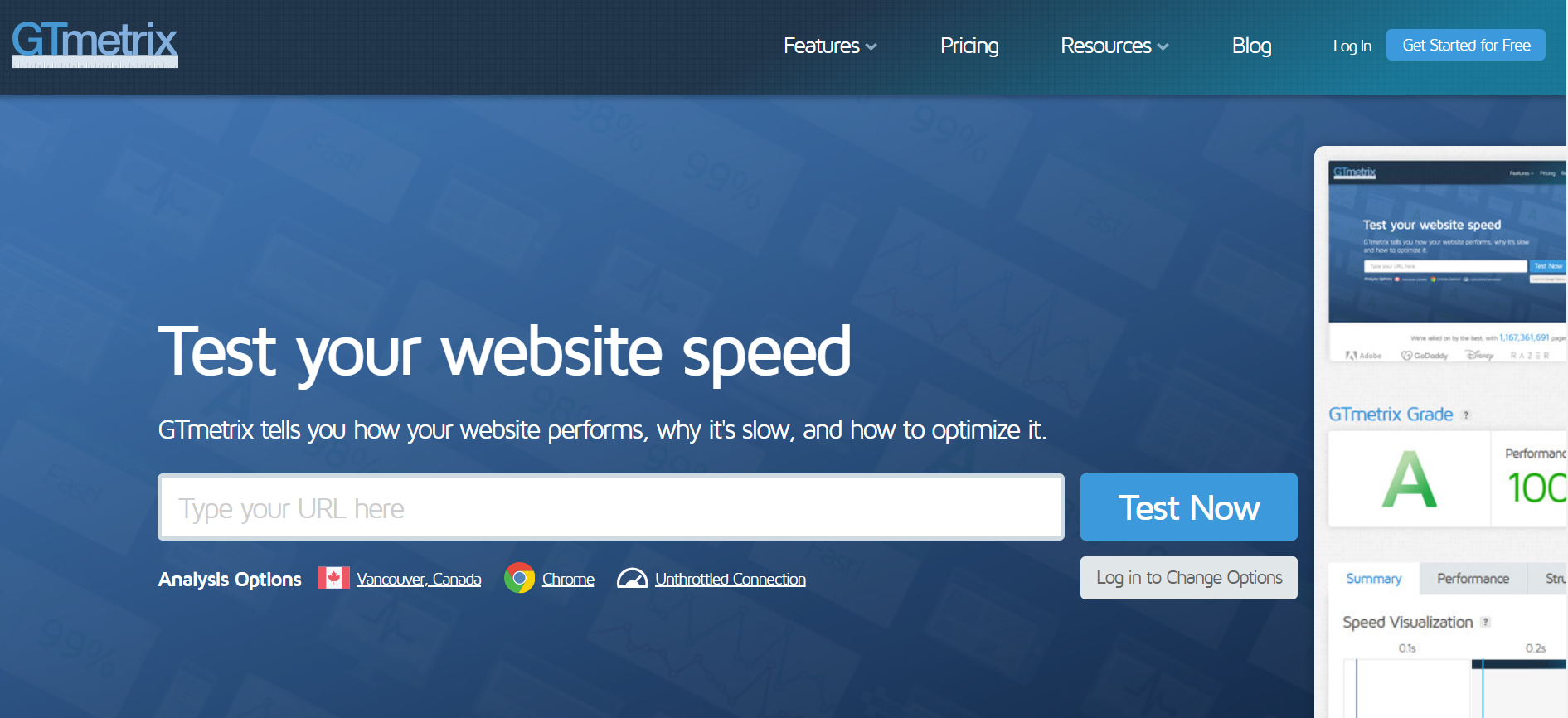
Moreover, the Shopify Theme Detector tool helps you identify if your theme is contributing to slow loading times. Choosing a fast, lightweight theme can significantly improve your site’s speed.
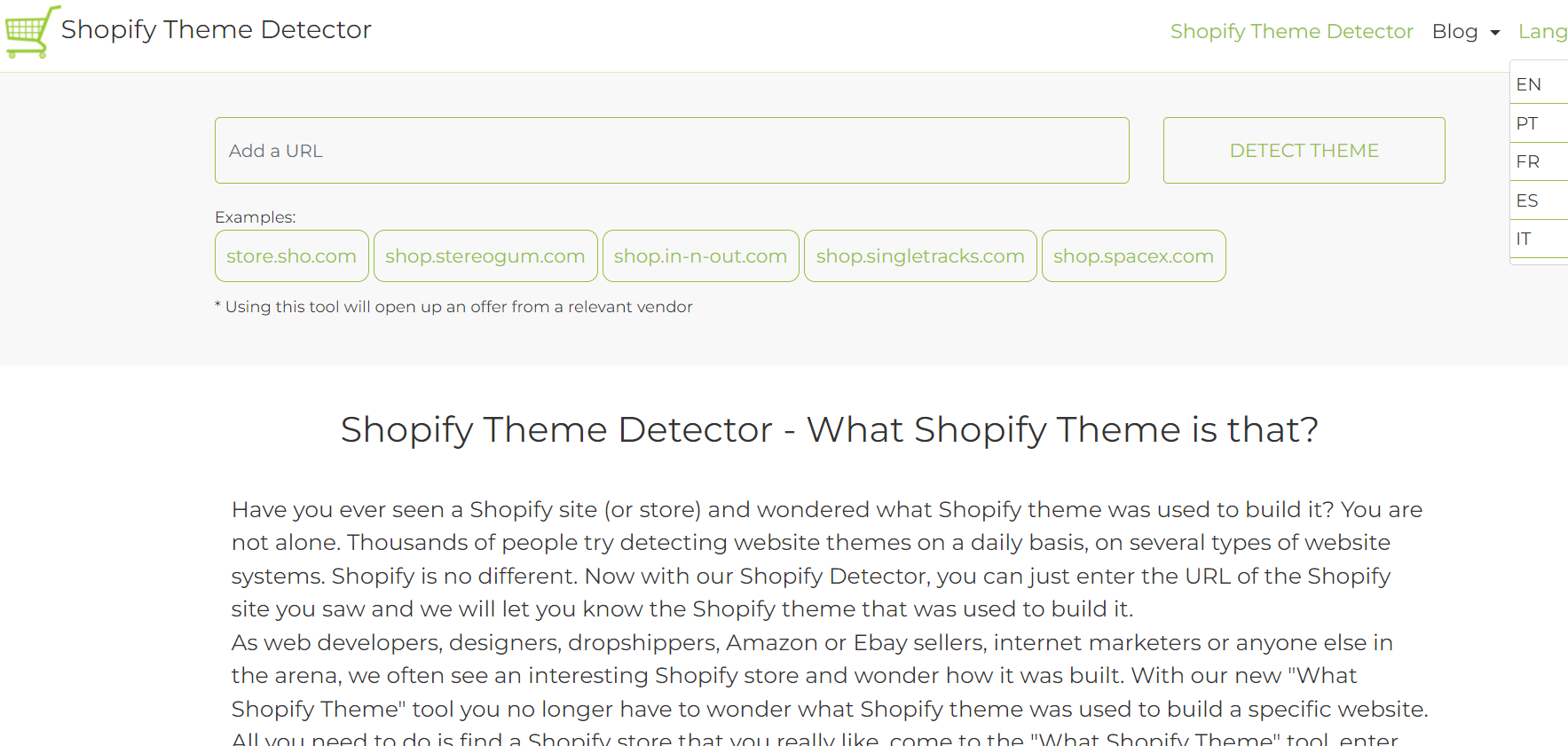

8. Social Media Ads
When it comes to driving traffic to your Shopify store, social media ads are essential for reaching potential customers.
First, social media platforms offer extensive targeting options. You can narrow down your audience based on demographics, interests, and behaviors. This way, you can engage with the right people who will probably convert into customers.

So, with Facebook Ads Manager and Instagram Ads, you can create highly targeted campaigns.
For example, you can target users who have shown interest in similar products or follow related pages. This increases the chances of your ads being seen by those who are already interested in what you offer.
Of course, these people will be interested in your business and will visit your website. And, there you go, more visitors, and more traffic on your Shopify store.
Additionally, Facebook Pixel helps you track the performance of your ads and optimize them for better results.
By analyzing data from Pixel, you can understand which ads are driving the most traffic and conversions, allowing you to adjust your strategy accordingly.
9. Facebook & Instagram Ads
Facebook and Instagram are great platforms to bring more visitors to your Shopify store. With their huge user bases and strong advertising tools, they help you reach and connect with the right people.
On both platforms, you can use different types of ads to promote your dropshipping business.
Facebook Ads include:
- Image Ads
- Video Ads
- Lead Ads
- Dynamic Ads
- Story Ads
- Collection Ads
- Slideshow Ads
- Messenger Ads
These options let you create ads for various goals, like increasing brand awareness, getting leads, or boosting sales.

Instagram offers several ways to display your products:
- Image and Video Posts
- Reels
- Stories
Using hashtags and product tags can help more people find your posts.
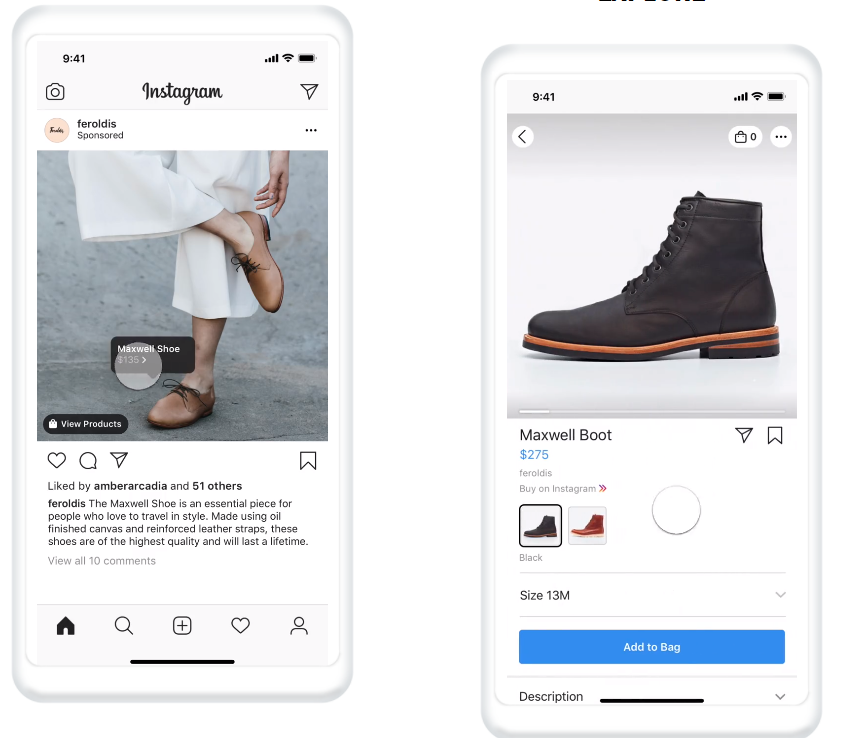
Instagram is known for its eye-catching content and influencer partnerships. Working with influencers can expand your reach and make your brand more trustworthy.
10. TikTok Ads
TikTok has become a leading platform in social media marketing. Did you know the average person spends 95 minutes daily on TikTok?
Compared to the typical 6 hours per week on other social media, TikTok stands out as a prime choice for driving traffic to your Shopify Store.
So, to make the most of TikTok, use strategies like hashtag challenges, branded AR content, brand takeovers, and in-feed ads.
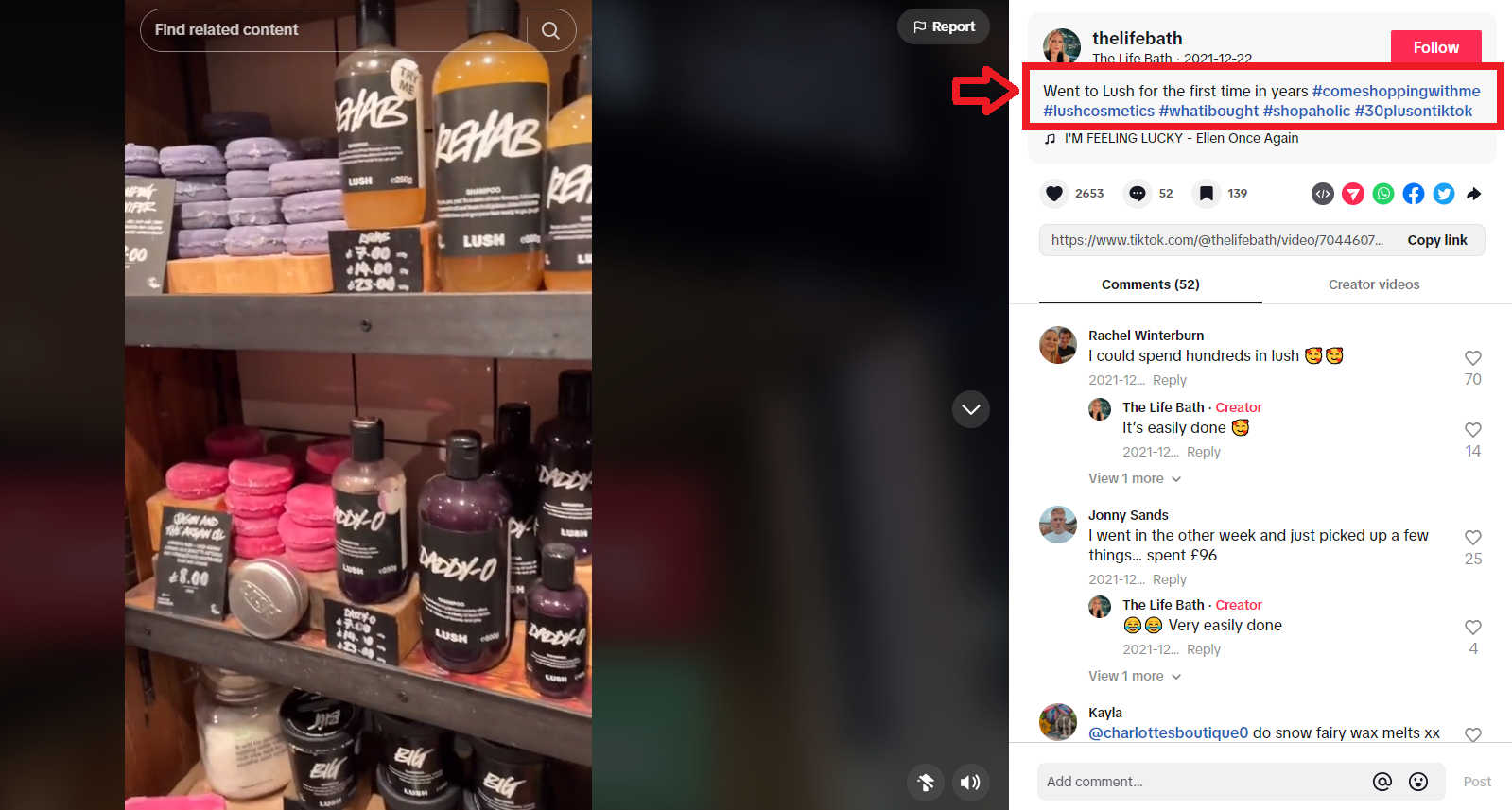
Trending sounds can also help your videos go viral quickly. Including links in your videos that direct viewers to your store can significantly increase traffic.
For example, I admire how @redbull stands out by sharing high-energy, adventurous content that perfectly matches its brand identity, attracting a dedicated and loyal audience.
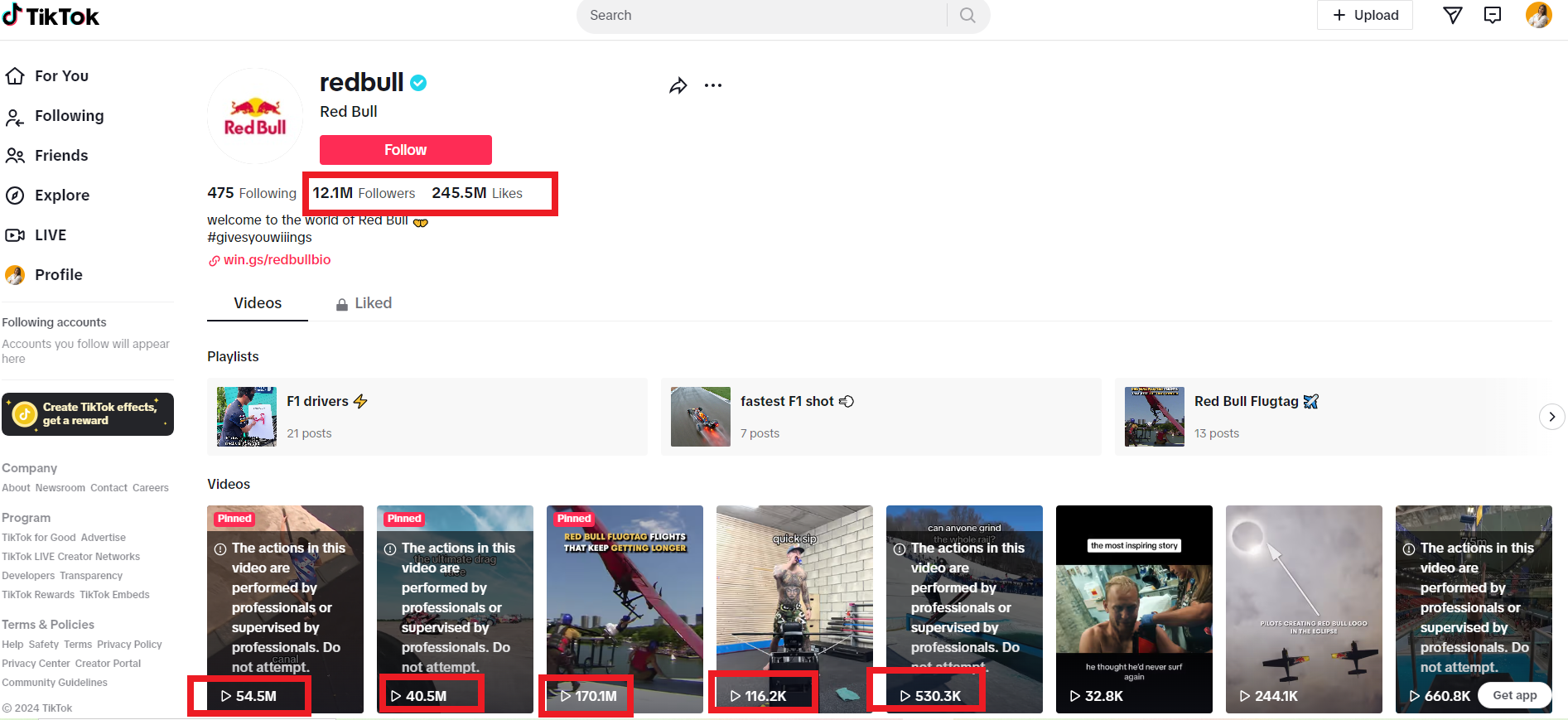
You can use this approach by highlighting the unique features of your products or telling your brand’s story.
11. Pinterest Ads
Pinterest is all about eye-catching visuals, so make sure your product images are high-quality and visually appealing.
Therefore, use professional product photography or create compelling graphics that catch the attention of users scrolling through their feeds.

For example, Whole Foods excels at using Rich Pins on Pinterest for e-commerce. As a health-focused supermarket, Whole Foods uses Rich Pins to add more details to its posts, which helps with SEO on Pinterest.
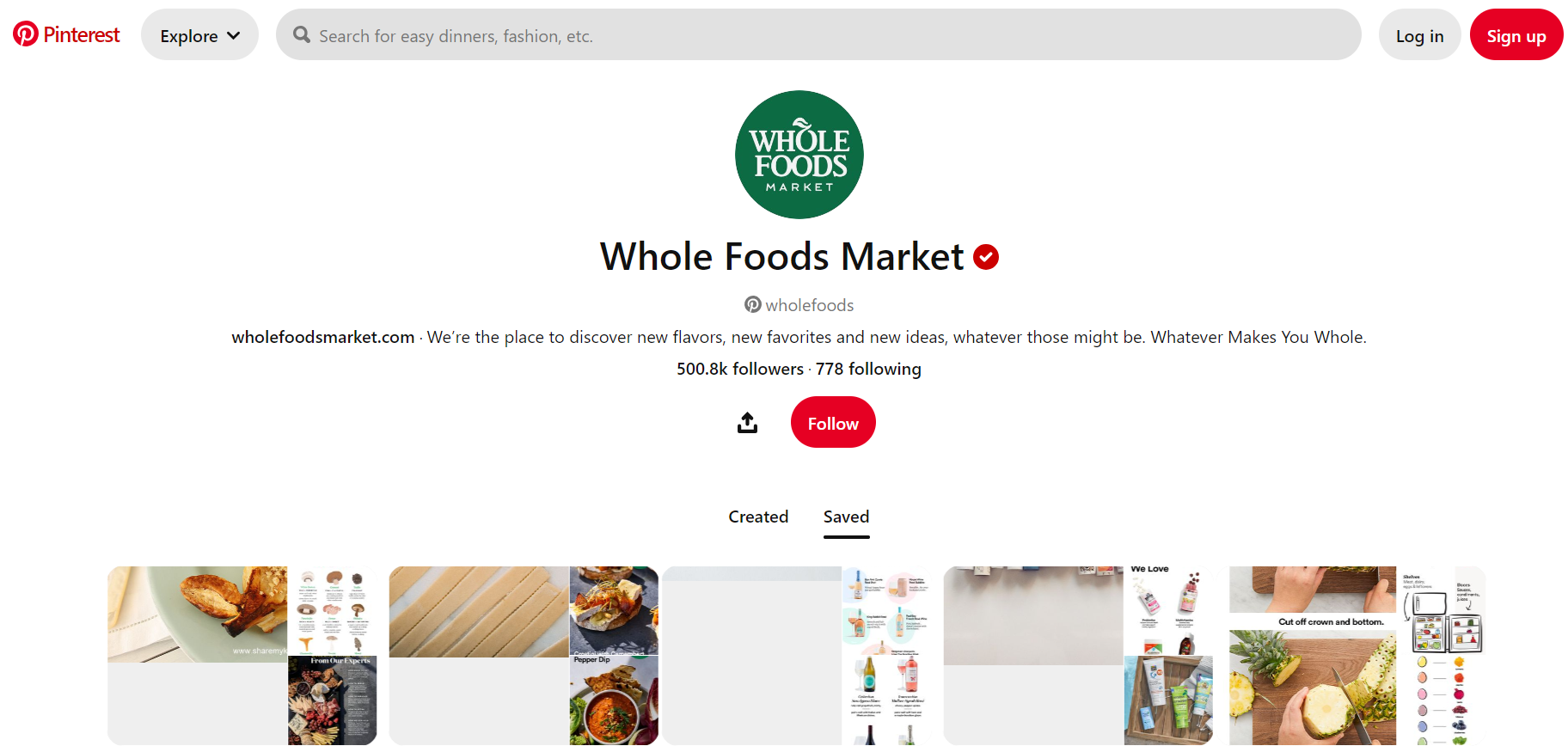
These pins allow the brand to share cooking tips, show real-time product availability and link to their blog posts. Rich Pins can also drive app downloads, link to articles, or direct users to in-stock products.
Like other social media platforms, Pinterest relies on keywords to help users discover content. Optimize your pin descriptions with relevant keywords that align with your target audience’s interests and search queries.
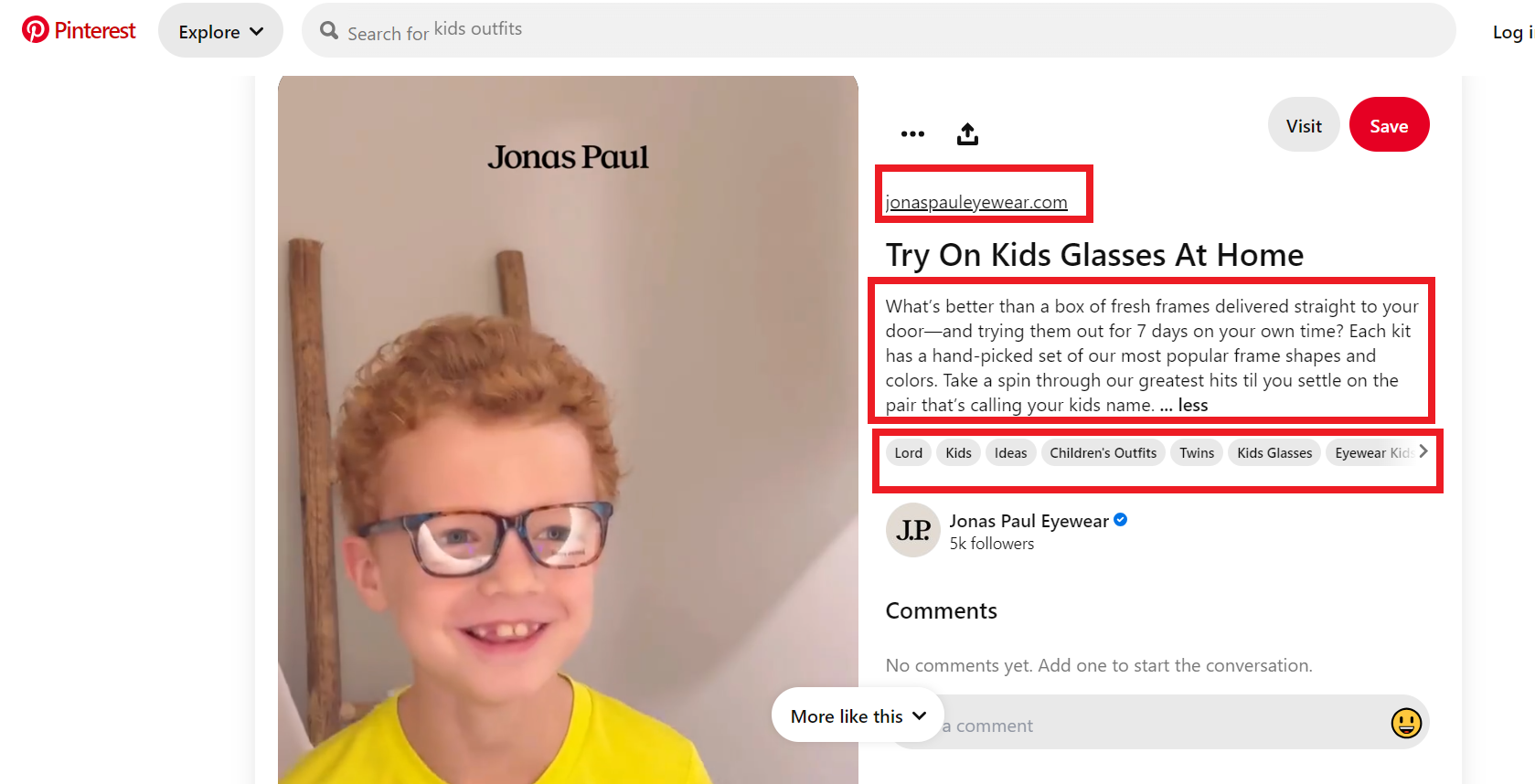
Additionally, using relevant hashtags can expand the reach of your pins and increase visibility. And, the most important part- do not forget to link your website in the description of your pins.
12. Video Marketing
If you want to drive traffic to your Shopify store, videos are a MUST. Through videos, you can present your products in an engaging and informative manner, allowing potential customers to see them in action and understand their features and benefits.
So, by creating tutorials and how-to videos, you demonstrate how to use your products while positioning yourself as an expert in the field. This builds trust with your target audience and enhances your brand’s credibility.
What’s more, search engines favor video content, so incorporating videos can help improve your SEO rankings. This means your store is more likely to appear in search results, driving organic traffic.
For example, Gymshark, a popular fitness apparel brand, uses video marketing exceptionally well on its Shopify store.
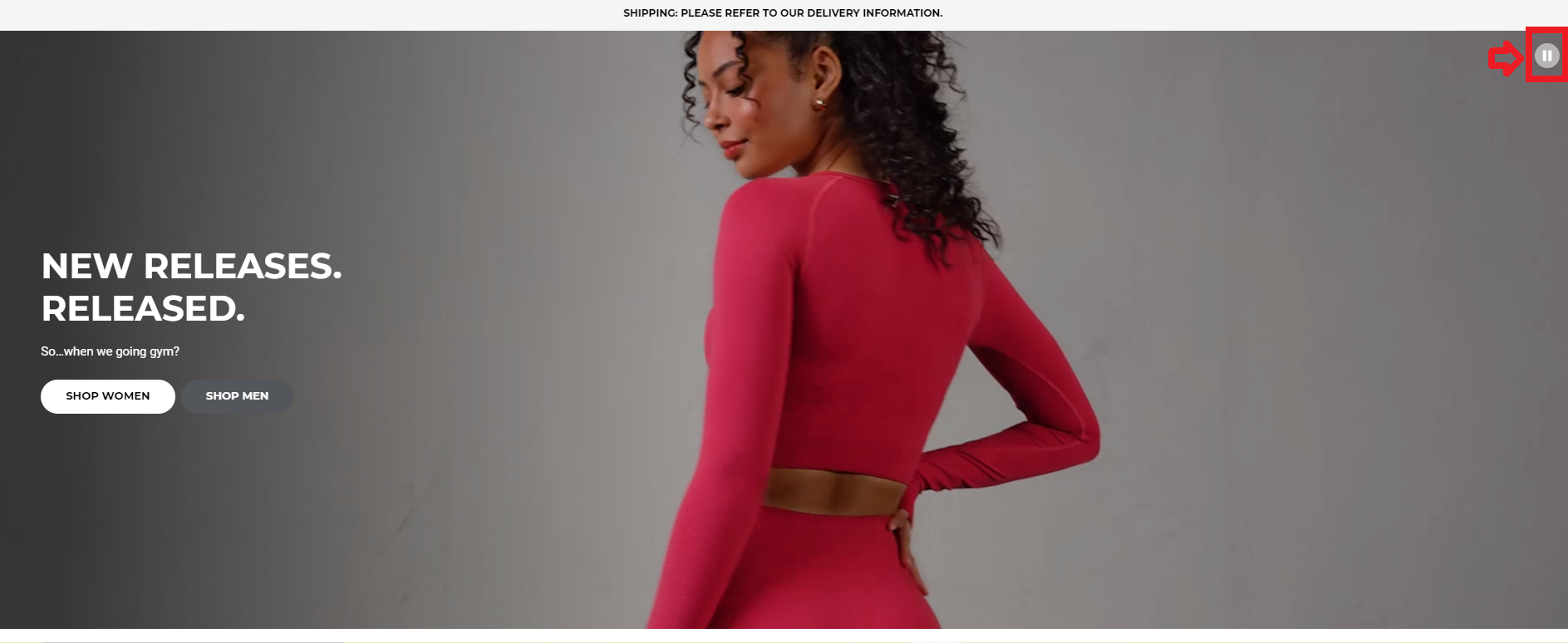
They create engaging content that showcases their products in action, such as workout routines, product demonstrations, and influencer collaborations. By doing so, they effectively connect with their audience and drive traffic to their store.
Also, I find video ad services like DropshipMedia incredibly useful for my video marketing needs. They offer a wide range of pre-made video ads specifically designed for promoting products.
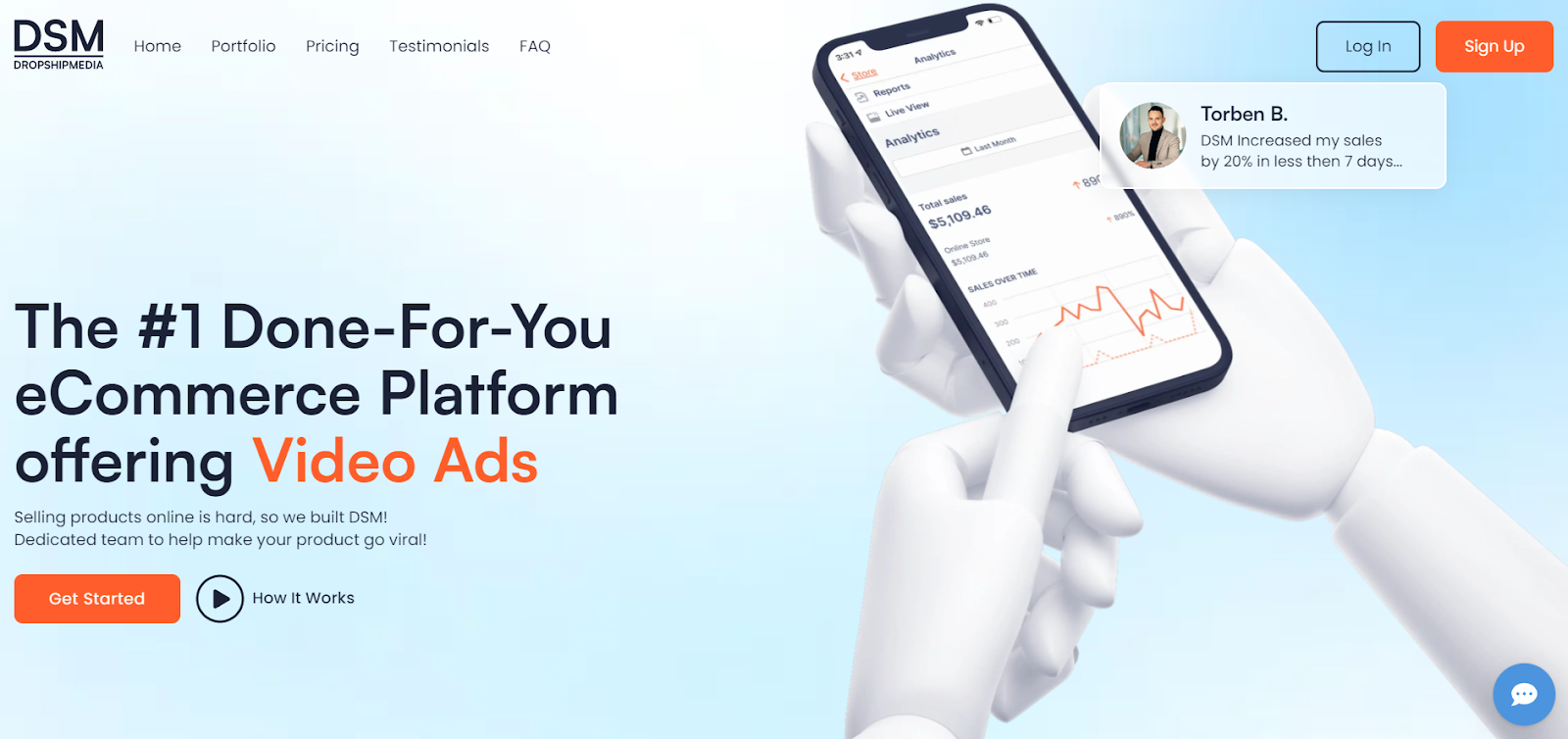
Their service includes free thumbnail images, professionally crafted ad content, logo branding, and the option to request unlimited revisions to ensure your ads are perfect.
13. Influencer Marketing
Influencers with a strong social media presence can greatly expand the reach of your Shopify store. By partnering with influencers whose audience matches your target market, you can access a ready-made community of potential customers.
One major advantage of influencer marketing is working with micro-influencers. These are individuals with smaller but highly engaged audiences who often specialize in specific niches.
So, collaborating with micro-influencers lets you reach a highly targeted customer base and create content that truly resonates with your audience.
Thus, to find and evaluate potential influencers, I use the HypeAuditor tool. This app provides valuable insights into influencers’ audiences and engagement rates. You can get information on engagement rates, audience demographics, interests, and more.

14. Run a Blog
Running a blog related to your Shopify store can play a crucial role in driving more traffic. By creating valuable and relevant content, you can attract potential customers and build trust with them.
Consider including various types of content such as articles, case studies, podcasts, and webinars. These formats not only provide valuable information to your audience but also help establish a connection with them.
By sharing insights and knowledge, you can engage customers and keep them interested in your products or services.
For instance, I run a blog for dropshippers where I educate them on how to establish and run a successful dropshipping business. I write about various aspects of dropshipping, providing tips and strategies, how-to guides, trending products, best suppliers reviews, etc.

This approach allows me to engage with potential customers, establish my expertise, and drive organic traffic to my website.
To manage and optimize your blog, you can use tools like WordPress for creating and publishing content, and Yoast SEO for optimizing your posts for search engines.

15. Run Giveaways
Run engaging contests or giveaways on social media channels. This way you will encourage user participation and get more followers. Well, this people will become your potential buyers.
Giveaways can attract a large audience, increasing your store’s visibility. Thus, participants often share the giveaway with their networks, broadening their reach.
Also, they are an effective way to collect email addresses and build your email list, providing valuable leads for future marketing campaigns.
For example, Pura Vida Bracelets is a popular Shopify store known for running successful giveaways.
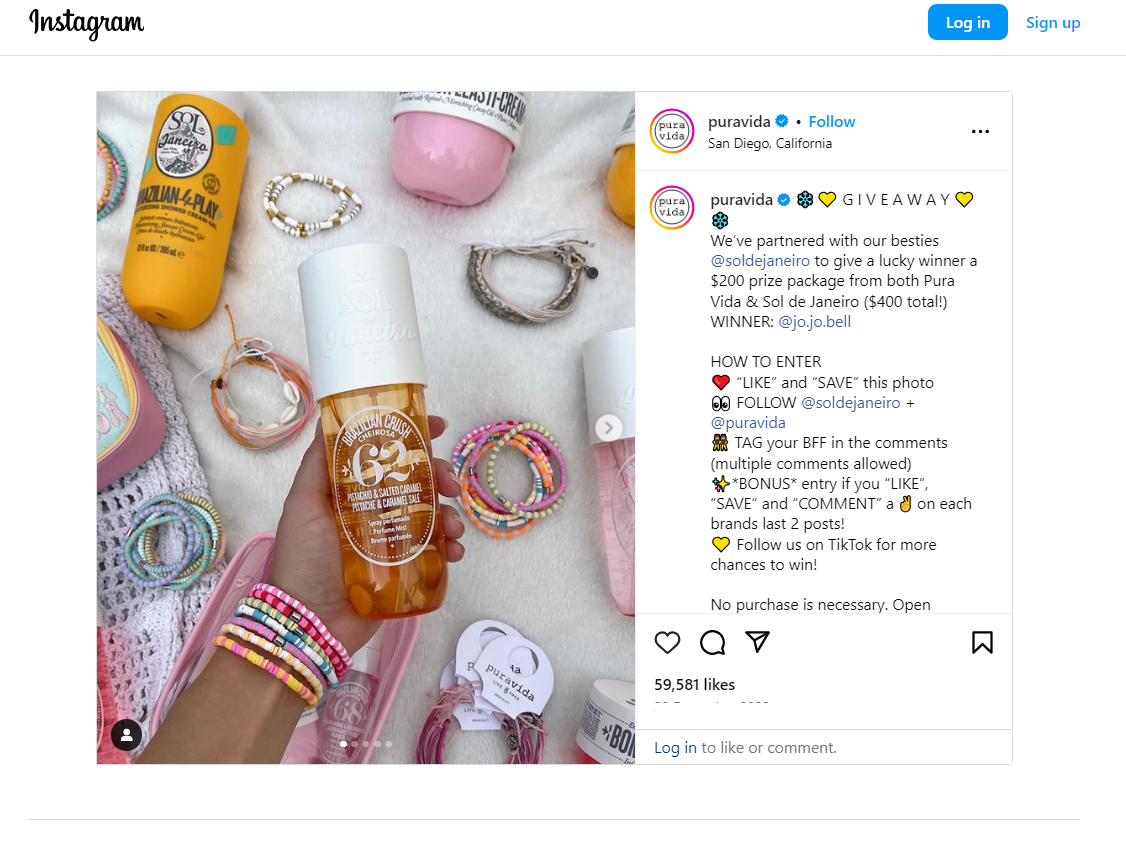
They often offer bundles of their popular bracelets and accessories as prizes, which appeals to their target audience. Participants are usually required to follow Pura Vida on social media, like and share the giveaway post, and tag friends in the comments to enter.
16. Post Your Store on Reddit
Reddit, known as “The Front Page of the Internet,” is a vast and diverse online community with millions of active users.
So, posting your Shopify store on Reddit can significantly boost traffic to your Shopify store if done strategically.
In fact, Reddit is divided into various subreddits, each dedicated to specific interests, hobbies, and topics.
By posting in relevant subreddits, you can reach a highly targeted audience that is already interested in your niche. Plus, their users value authenticity and genuine interactions.
Therefore, by engaging with the community, answering questions, and providing valuable content, you can build trust and establish your store as a credible source.
For example, Beardbrand sells grooming products for bearded men, and effectively used Reddit to boost traffic and grow their brand.

Their targeted subreddits such as r/beards, r/malegrooming, and r/wicked_edge, where their target audience is active and engaged.
Also, rather than directly promoting their products, Beardbrand’s founder, Eric Bandholz, shared informative posts about beard grooming, maintenance tips, and personal experiences.
17. Offer Discounts
Offering discounts can be a powerful strategy to drive traffic to your Shopify store. Discounts attract attention and create a sense of urgency, encouraging potential customers to visit your store.
When people see that they can save money, they are more likely to click through to your website to check out the deals.
What’s more, promotions like limited-time offers or seasonal sales can create excitement and urgency. Shoppers don’t want to miss out on a good deal, so they are more likely to act quickly.
This can lead to an increase in both traffic and sales during the promotional period.
Therefore, use tools like Shopify’s discount codes and automatic. You can create percentage discounts, fixed amount discounts, or even free shipping offers.
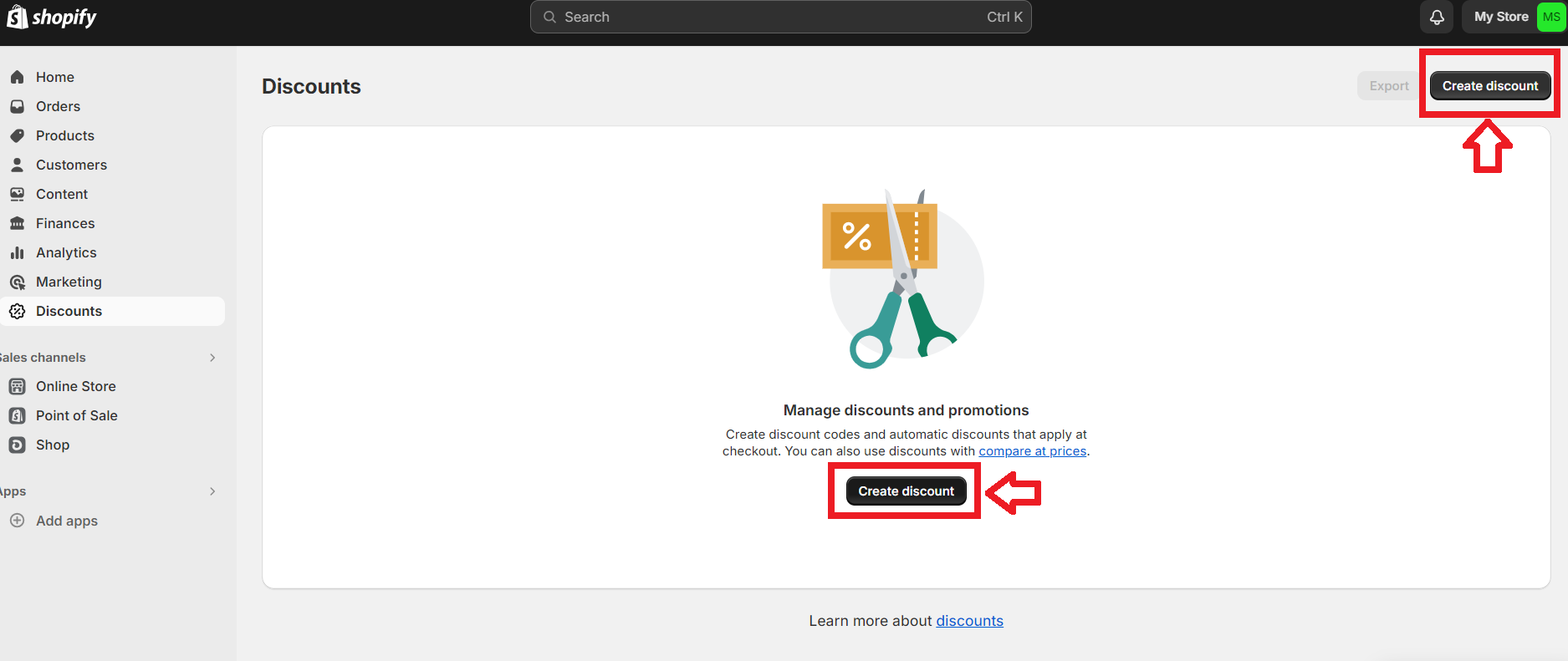
For example, you might offer a 10% discount on first purchases to entice new visitors or a buy one, get one free deal to encourage larger orders.

18. Include Referral Programs
Referral programs are a powerful way to drive traffic to your Shopify store by leveraging the networks of your existing customers.
When customers are satisfied with your products or services, they are naturally inclined to share their positive experiences with friends and family.
By offering rewards for referrals, you motivate your current customers to spread the word about your store. This personal recommendation is highly effective because people tend to trust the opinions of their friends and family over traditional advertising.
As a result, referred customers are more likely to visit your store and make a purchase.
What’s more, referral programs also have the potential for viral growth. As new customers are referred and become satisfied with your products, they, in turn, refer more people.
This creates a cycle of continuous growth, significantly enhancing your store’s visibility over time.
For example, Lulus has a referral program designed to reward customers for bringing in new shoppers.
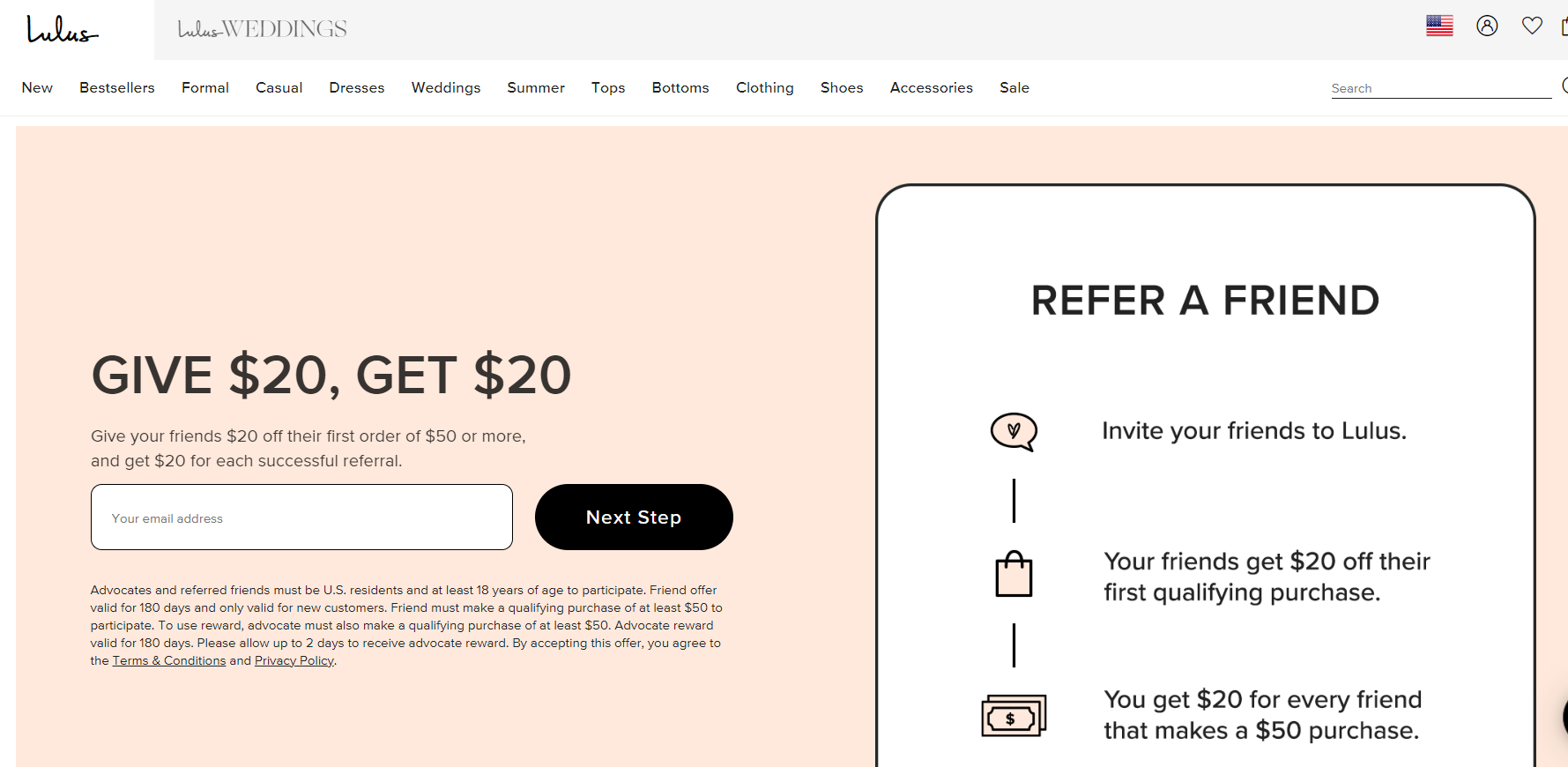
Hence, if you invite a friend to Lulu’s, they get $20 OFF for their first order. As for you, you get $20 for every friend that makes purchases over $50.
Conclusion
Understanding how to get traffic to your Shopify store is crucial for your e-commerce success.
Throughout this article, I’ve explored various traffic sources, from mobile devices to search engines, social media, email marketing, referral traffic, and paid ads.
In my opinion, prioritizing SEO and optimizing your store is one of the fundamental steps.
Additionally, leveraging social media platforms, particularly Instagram, and crafting personalized email marketing campaigns can significantly boost your reach and conversions.
What’s more, referral traffic and paid ads also play a vital role. Plus, collaborating with influencers, using affiliate marketing, and running targeted ad campaigns can drive substantial traffic to your store.
Each of these strategies has unique benefits and should be tailored to your specific audience and business model.
However, before diving into these strategies, consider your target audience, budget, and business goals.
Remember, the key is to be consistent, monitor your results, and be willing to adjust your strategies as needed.















![The Top 21 3PL Companies Compared [2025 List & Guide]](https://images.weserv.nl/?url=https://prod-dropshipping-s3.s3.fr-par.scw.cloud/2024/03/Frame-3922469.jpg&w=420&q=90&output=webp)